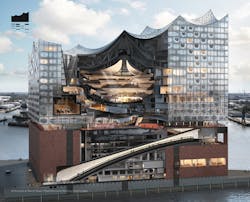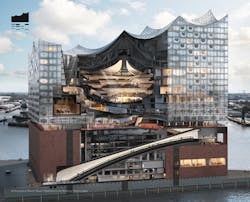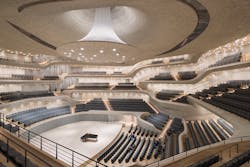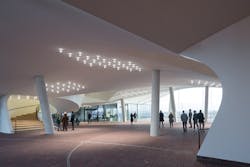Hamburg's glorious Elbphilharmonie has been over a decade in the making. Forward-thinking architects prescribed solid-state lighting from the start, even before the technology was ready for ambience. A thousand handblown glass balls from the Czech Republic made the difference, MARK HALPER discovers.
Think back to 2006. The lighting revolution was rising. LED lamps and luminaires were about to make significant inroads. Early adopters could see enormous potential for energy savings, and would soon begin placing orders both for commercial deployment and for retail sale.
Interested in articles & announcements on architectural lighting?
In those dawning days, though, even die-hard enthusiasts had to admit that LED light quality - warmth, for example - couldn't match that of venerable, flame-like incandescent technology.
That didn't matter to some users. But it mattered a lot to the Swiss architects who at the time were designing the soaring and illusorily sailing Elbphilharmonie concert venue along the Elbe River in the busy port city of Hamburg, Germany. They insisted on pioneering the use of modern, energy-saving LED illumination in the performance hall, but they needed a way to soften its light.
Their firm, Basel-based Herzog & de Meuron, is renowned for Beijing's "bird's nest" Olympic stadium, London's Tate Modern and San Francisco's de Young museums. It had nothing less inspiring in mind for the Elbphilharmonie, a glorious but troubled project that would take more than a decade to complete, having finally opened in January of this year after long delays and a budget that escalated tenfold to around $840 million.
The Grand Hall inside the complex was to become a modern, classical music venue, seating 2100 people. It would be asymmetrical and in the round like the renowned Berlin Philharmonie, but with its own shape, swirls, angles, and forms. It would include 10,000 acoustic gypsum fiber panels, each with a unique pattern. And it would feature an inverted mushroom-shaped structure pointing like a ship's horn down from the center of the high ceiling to deflect sound back to the ears of musicians and the audience.
Good lighting would enrich the elegance. Harsh light would ruin it. Yet from the design's inception - in the days when LED light was harsh - Herzog & de Meuron, with an unflagging commitment to technological progress, prescribed SSL, prevailing over other voices that wanted halogen. To take the edge off, the architects had a solution: handblown glass balls. Or more precisely, 1200 handblown glass balls that house the hall's dimmable LEDs, adding a luminescent ambience while at the same time evoking the look of water bubbles in homage to the Elbe that flows outside (Elbphilharmonie translates as "Elbe Philharmonic Hall").
"The thick handblown glass was interesting for us because it brings back a material quality which you typically lose when you work with LED light," said Herzog & de Meuron senior partner Ascan Mergenthaler, recently reflecting on the project for LEDs Magazine. "They're great light sources, very energy efficient and good to play with. But they're banal somehow. Through that handblown glass, you get almost like an old-school quality back to it, something we all like about lighting."
The 1200 glass balls line the underside of the terraced balconies in the hall, undulating in yet another evocation of the river that runs outside to the North Sea and is the artery that makes Hamburg the second largest port in Europe after Rotterdam.
Easier said than done
It's one thing to specify handmade glass LED luminaires. It's another thing to implement them; it's not something that most LED lighting vendors happen to have in their catalog.
The task fell to Austrian lighting supplier Zumtobel.
"It's a design feature the architects Herzog & de Meuron wanted to have," recalled Julian Lonsdale, a Zumtobel designer. "The way it appears in the room, it looks fantastic, because it looks like little water drops. It was their design approach and idea. It's the way they wanted it, and it's the way we did it."
It wasn't easy. The first hurdle: Herzog & de Meuron specified a glass shape that would be thicker on the top than on the bottom, which, as Lonsdale noted, runs counter to typical glassmaking.
"This was one of the issues we had to tackle, which was very difficult," said Lonsdale. "We could hardly find any manufacturers who could manufacture this ball industrially."
Zumtobel's two-year search for a glassmaker eventually led the company to Detlef Tanz, an individual glass specialist in Wegberg, Germany, who had previously worked with Herzog & de Meuron, and who Lonsdale described as "an artist with a network of manufacturers worldwide." Tanz turned to the Cerveny glassmaking company in the Czech Republic to produce the glass balls.
Finding Tanz was a big step forward. But other challenges followed. One handblown glass item is by nature different from the next of its kind. Cerveny's glass works were no exception. As Lonsdale tells it, the differences were often enough so that each would disperse light differently than the next. "Every glass has its own irregularities," he said. "We had to measure the different balls to apply them in different areas of the building. It's not like a standard luminaire where the light distribution is always identical. These have quite severe differences in them."
The more things change, the more they don't stay the same
Further compounding the problem: The Elbphilharmonie experienced protracted and controversial delays, a lawsuit, and calls for an investigation into cost overruns. At one point construction even stopped for a year out of structural concerns. In the decade or so from commissioning to January's grand opening, the quality and properties of LED light sources changed many times, often becoming more luminous and complicating the matter of how each would emit light through whichever of the 1200 glass balls it ended up in.
It all added up to a painstaking process of deciding exactly where to place and how to space each luminaire within the hall and its several terraces of seating. Nicole Drong, head of sales for Zumtobel's Hamburg office, noted that new LEDs could emerge every two or three months. Each time, she said, "The lighting calculations had to begin anew."
Eventually, Zumtobel had to insist that construction company Hochtief - the lead building contractor for the Elbphilharmonie - place its final order.
"Over this long run, we never really had a final fixed design suite of the product. It was always in progress," said Lonsdale. "Until at some point we had to say we have to stop developing this. With one of these projects, which is so exposed and really so beautiful, you have to take high risks and do all of the things that maybe other companies can't do, but we also needed to do very intense development to keep up with the evolving technology. It was difficult. It cost a lot of time and money.
"We often have this kind of issue with long-running projects worldwide. If we have a specification from 2010 or 2012 and we have to deliver in 2017, there's been such a long change in between that we often have issues with these questions. We guarantee a certain luminous lux level, and all of a sudden, the modules we get from the market are a lot more powerful, so they make more light. These are aspects we have to deal with. It was an aspect of the Elbphilharmonie, because it was one of the longest running projects ever."
As if that were not enough to worry about, Drong recalled that her "biggest problem" with the glass ball project was the constant uneasiness associated with having only one supplier. "I was always thinking, 'What if something happens to Mr. Tanz?'"
The Elbphilharmonie being a concert hall, there were acoustic challenges related to the lighting, too. Drong and Lonsdale recalled how the metal housings in the fixtures that hold the balls to the ceiling can noisily resonate in response to certain musical frequencies. LED driver boards and power supplies can also hum.
"That would of course be a big issue for the musicians in a concert hall," said Lonsdale. "There were no real rules saying acoustic luminaires should do this, that, and the other. So we just had to find out how to proceed."
To eliminate noise from the electronic components, Zumtobel collaborated with Switzerland's Lucerne University of Applied Sciences and Art. To stop the housing from reverberating, Zumtobel applied a cushioning material based on a specialized silicone that avoids the harmful effects silicone can cause on diodes.
A dim view
Then there was the issue of lighting controls. In the early days, Herzog & de Meuron wanted to be able to adjust the LED lighting both by brightness and color temperature.
While Zumtobel was able to provide one or the other, technological limitations prevented it from providing both controls, forcing the architects to choose.
Along the way, as the ten years went by, LEDs' color temperature fell (warmed, in the counterintuitive language of color and the Kelvin scale) to 2700K, on a nominal par with incandescent. With the lighting now at a satisfactory warmth, Herzog & de Meuron chose to go with dimming only.
The LED glass balls are not the only light sources in the concert hall. There are at least two others. The upside-down, fabric-wrapped mushroom, which as its primary mission buttresses the acoustics, also serves a lighting function. It houses LED tubes from Germany's Flashaar LEDLight that shine through the mushroom's translucent material up at the ceiling. That light in its own right washes out the appearance of the fabric, so another series of Flashaar LEDs along the wide bottom of the structure point up at the stem and restore the fabric's appearance.
As a third light source, LED stage lights point down to the performance floor from the upside-down mushroom cap, and halogen stage lights shine from the ceiling's catwalk areas, provided by Middleton, WI-based entertainment lighting company ETC. And that's just the concert hall.
The Elbphilharmonie is a combination of old and new. The Grand Hall sits inside the new portion, which from the outside looks like glass sails - formed by 1000 curved window panels that also house a hotel, apartments, and one of the two smaller music halls. The sails reach about 350 ft into the sky, making the Elbphilharmonie the tallest occupied building in Hamburg. They rise up from the "hull" - an old cocoa, tea, and tobacco red-brick warehouse, gutted and refurbished to house restaurants, a performing studio, a parking garage, and a tubular escalator winding its way up from ground level.
It all needs artificial lighting, including the so-called "Plaza," the area atop the old warehouse that serves as a bright and airy public concourse bestowing a tremendous view of the city and leading to the main concert hall.
Extending the ball game
For the Plaza's artificial lighting, Herzog & de Meuron also specified ball-shaped LED luminaires, carrying through with the water bubble motif, further honoring the importance of maritime commerce to Germany's second largest city after Berlin. But rather than stipulating handblown glass, the architects settled for a polycarbonate material, which is a type of thermoplastic. Zumtobel provided 870 of them. Herzog & de Meuron prescribed a layout that groups them into sets of rhomboids, creating intermittent patterns of brightness across the concourse, adding to its visual interest.
"The luminaires are arranged in rhomboid fields, rather than spread out evenly - this allows for modulation of light on the plaza," said Mergenthaler.
In yet another area - the foyer and cloakroom - the architects specified 750 lights in a third style, which combines LEDs and tubes that Zumtobel describes as fluorescent and the architects refer to as neon, all in one fitting. The curved tubes provide a stylish look and general illumination. The Philharmonie can use the LEDs to change colors that suit different moods and events, via RGB controls.
Not all of the lighting at the Philharmonie is Zumtobel's. The Grand Hall's mushroom and catwalk lighting from Flashaar and ETC, for instance. Likewise, Germany's S[quadrat] GmbH provided the giant LED display screen at ground level, which serves as an information board and also delivers eye-catching visual shows.
So how much did all the lighting cost? Neither Zumtobel nor the architects would say. But as plans and technologies changed, and with 1200 handblown glass balls on hand, this was no bargain-basement deal for anyone.
"When you talk about the issues and the complexities we had, the development costs were of course very, very high," said Lonsdale. "But on the other hand, we have a beautiful project on our hands as a reputation. And the work with the architects - they really gave us so much input and fresh ideas and new perspectives. So this is something that doesn't necessarily pay off in one project. It pays off over the years."
The Grand Hall opened in January, with German chancellor Angela Merkel on hand and the newly renamed NDR Elbphilharmonie Orchestra - formerly the NDR Symphony Orchestra - performing. The Chicago Symphony Orchestra played during the inaugural week. The New York Philharmonic is on its way in April, as are many other top acts from classical, jazz, folk, and other genres (Nashville's Lambchop alternative country band was booked in February), filling the place with what should be magnificent sound. The LED light won't be bad, either.
MARK HALPER is a contributing editor with LEDs Magazine ([email protected]).










